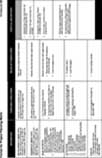[Front page] [Contents] [Previous] |
Project Cycle Management Manual
Annex
Annex
Enclosure A - Project Idea Format
Enclosure B - Project Document Format
Enclosure C - Terms of Reference Format
Enclosure D - Appraisal Report Format
Enclosure E - Guidelines for Steering Committee
Meetings
Enclosure F - Covering Letter to Progress Report
Enclosure G - Letter of Confirmation
Enclosure H - List of DANCEE Indicators
Enclosure I - References
Enclosure A
Project Idea Format
Project Idea Format
| Max. no of pages | |
| Table of contents | |
| The total number of pages should not exceed 5 (enclosures excluded). | |
| I. The project cover sheet (please refer to Enclosure BI
in Enclosure B) II. Map of location III. List of abbreviations |
|
| 1. Context 1.1. Project idea 1.2. Significance of the environmental, nature or health problem 1.3. Legal framework, EU environmental legislation and NPAA if applicable 1.4. Institutional set-up, stakeholder identification and analysis 1.5. Prior, on-going or planned assistance to the sector |
1 |
| 2. Definition of project interventions 2.1. The development objective 2.2. Immediate objective 2.3. Outputs 2.4. Activities 2.5. Inputs 2.6. Assumptions, risks and preconditions 2.7. Dissemination of project results |
1 |
| 3. Compatibility with DANCEE policies and the country programme 3.1. Programme priority areas covered by the project 3.2. Programme priority criteria targeted by the project |
1 |
| 4. Outline projects implementation plan | 1 |
| 5. Budget outline (please refer to Enclosure A1) | 1 |
| Annex 1 The project organisation (including a presentation of the applicant, its local partners and the resources of the beneficiary organisation and stating the responsibilities of the various parties) |
|
| Annex 2 Presentation of the applicant | |
| Annex 3 Declaration on public debt not exceeding DKK 100.000 | |
Project Idea Format
The project idea must be submitted in English and should not exceed 5 pages. The description of the project idea should as a minimum be 1-2 pages and should include the topics underlined in the Project Idea Format (refer to opposite page). The subjects to be described are in general the same as for the project document (Enclosure B). However, the intention of the project idea format is that the level of detail and the accuracy of the information are considerably less than those required for the project document.
Applicants are not required to formally submit a project idea, but applicants may do so if they find the procedure helpful. Approval of a project idea cannot be interpreted to mean that funding for the application project will eventually be provided.
For an explanation of the different topics please refer to Enclosure B.
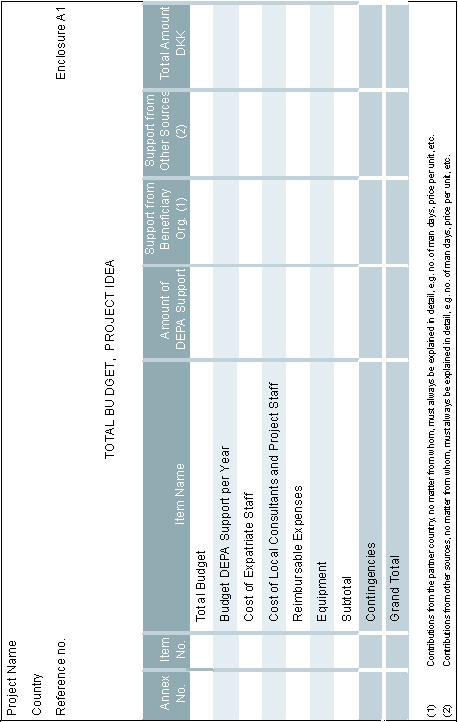
Enclosure B
Project Document Format
Figure 1: Project Document Format
| Max. no of pages | |||||||||||||||
| Table of contents | |||||||||||||||
| I. The project cover sheet (please refer to Enclosure B I) II. Map of location III. List of abbreviations IV. Executive summary |
2 | ||||||||||||||
| 1. Context 1.1. Project idea 1.2. Significance of the environmental problem 1.3. Legal framework, EU environmental legislation, and NPAA if applicable 1.4. Institutional set-up, stakeholder identification and analysis 1.5. Prior, on-going or planned assistance to the sector |
6 | ||||||||||||||
| 2. Definition of project interventions 2.1. The development objective and corresponding indicators 2.2. Immediate objective and corresponding indicators 2.3. Outputs and corresponding indicators 2.4. Main activities 2.5. Inputs 2.6. Assumptions, risks and preconditions |
8 | ||||||||||||||
| 3. Compatibility with DANCEE policies and the country programme 3.1. Programme priority areas targeted by the project 3.2. Programme priority criteria targeted by the project |
1 | ||||||||||||||
| 4. Implementation 4.1. Project implementation plan with phases 4.2. Organisation and administration 4.3. Reporting, monitoring and reviews 4.4. Dissemination of project results 4.5. Budget 4.6. Accounting and Auditing |
5 | ||||||||||||||
Annexes to the project document.
|
|||||||||||||||
Project Document Format
The project document must be submitted in English and should not exceed 20 pages (excluding annexes). The project document should include the sections shown in Figure 1. Brief explanations are provided below:
Sentences written bold are fixed headings and sentences in italics are comments and explanations.
Executive Summary
A paragraph of 15 - 20 lines indicating why the project is important. The summary should state the project’s context, including the project’s relation to other projects, the project’s objective and main activitie, the budget (specifying the contribution by DEPA and by other parties), the duration, the expected environmental impact, potential for replication and sustainability. The executive summary is official ex-ante project summary and will be in Danish and English.
1. Context
This section outlines the project idea and the significance of the environmental problem(s) it intends to solve. The major characteristics of the setting in which the project will operate are also described. The scope of the section is relative to the size and complexity of the project. It should deal with the following issues:
1.1 Project Idea
A brief overall description of the project idea. In one or two paragraphs, describe the problem which the project is intended to solve and how the project will solve it.
1.2 Significance of the Environmental Problem
Describe and analyse the environmental problem(s) to be solved and its/their significance. Specify the level of natural reesources and health-related problems in the project area and the expected impacts of the project.
1.3 Legal Framework, EU Environmental Legislation and NPAA if Applicable
Describe the partner country’s environmental legislation and for countries which apply for EU-membership, their National Plan for Adaptation to EU environmental legislation (NPAA).
1.4 Institutional Set-up and Stakeholder Identification and Analysis
Describe the beneficiary and other major stakeholders.
1.5 Prior, On-going or Planned Assistance to the Sector
Describe the assistance to the sector financed by national and/or international means.
2. Definition of Project Interventions
The project is planned and described using the logical framework approach. From the project description it should logically follow that the specified inputs will enable the specified activities to be carried out and the outputs to be produced. Similarly, the completion of outputs will lead to the immediate objective and contribute to the achievement of the development objective. For all elements, a number of external assumptions must be fulfilled to assure the success of the project.
In addition to the text, a project planning matrix should be annexed to the project document. A recommended format is shown as Annex 8.
2.1 The Development Objective and Indicators
The development objective represents the overall objectives to which the project’s immediate objective is expected to contribute. The development objective is described as a desired future situation
Indicators should be stated in operational and measurable terms, i.e. quality, quantity, time and place. Also the means of verification explaining how the indicator will be checked in practice, should be described
Example
| Development Objective | Verifiable Indicators | Means of Verification |
| The habitat and biodiversity of the watershed improved through enhanced capabilities of local communities and government agencies | Increase in the biodiversity and vegetation cover of the watershed by the year 2010 | Satellite and field verification |
2.2 Immediate Objective and Indicators
Indicate the immediate objective, its indicator and means of verification. The immediate objective states the specific purpose of the project and should address the problems described in Section 1.2 above.
The immediate objective states a desired situation at the end of the project if it is implemented according to the plans, and if the external assumptions are fulfilled.
| Immediate Objective | Verifiable Indicators | Means of Verification |
| Overall watershed management practised and enforced by local government agencies | First 5-year watershed plan prepared by local agencies
available in year 2005. Second 5-year plan available in 2010. Forestry, water and land use regulations followed by staff and communities in year 2005 |
Inspection of preparatory planning papers Observation of planning meetings, test of staff qualifications Inspection of quality and comprehensiveness of first and second 5-year plans Survey of development in breaks of regulation |
2.3 Outputs and Indicators
Describe the outputs produced directly by the project including indicators and means of verification. State only those outputs which are necessary and sufficient to achieve the immediate objective.
| Outputs | Verifiable Indicators | Mean of Verifications |
| Relevant planning tools are used by staff of Planning
Department for preparation of 5-year plans
Public hearing system institutionalised |
Quality of preliminary plans and preparatory papers prove the
correct use of planning tools by year 2002 Any relevant staff member can explain how to use the tools by 2001 Communities are informed of problems and plans Minutes and summaries available 2 weeks after hearing |
Quality control of plans Inspection of work routines Interviews and tests Community interviews on problems and plans Inspection |
2.4 Main Activities
Describe the main activities which must be carried out in order to produce and sustain the specified outputs. The activities should also be reflected in the project implementation plan
2.5 Inputs
List all inputs which are to be provided by the beneficiaries, other donors or financing institutions and the applicant. Inputs are all the resources to be used by the project and may include funds, personnel, equipment, land and building, etc.
2.6 Assumptions, Risk and Preconditions
State the specific assumptions which are beyond the control of the project management, but necessary for achieving project outputs or objectives. In case these assumptions do not hold true, there can be major risks to the project, and they should be carefully monitored throughout the project.
3. Compatibility with DANCEE Policies and the Country Programme
All projects supported by DANCEE should coincide with the overall DANCEE policy and the environmental strategy of the partner country. This section should therefore clearly demonstrate how these conditions are fulfilled.
3.1 Programme Priority Areas Targeted by the Project
DANCEE general priority areas are:
| air pollution | |
| water pollution | |
| solid and hazardous waste management | |
| biological diversity and sustainable forestry | |
| institutional strengthening |
Describe how the project fulfils DANCEE priority areas as spelled out in the specific country programme.(ref. Danish Environmental Support Fund for Eastern Europe, Co-operation Development 1991 - 96 and Priority Areas)
3.2 Programme Priority Criteria Targeted by the Project
Describe how the project relates to DANCEE’s criteria of priority as outlined in Section 1 and summarised below.
Needs and Wishes of Beneficiaries
A crucial criterion for DANCEE support is that projects should reflect the needs and wishes of the beneficiary institution. It is essential to the success of a project that it is understood from the beginning which services and products are of interest to the beneficiary. The term "beneficiary" is broadly defined and may include public and private enterprises, government authorities, NGOs etc.
It is a key criterion for DANCEE support that the support should be in agreement with national environmental legislation. Furthermore, support to countries applying for membership of the EU, must be consistent and in line with EU environmental legislation. Supplies and construction works should comply with EU environmental standards as well as with national standards.
It is a condition for DANCEE support that a project can be approved by the MoE. However, this approval will be obtained by DANCEE and not by the applicant.
Pollution Reduction, Nature Protection and other Environmental Benefits
The anticipated pollution reduction influences of a project constitute important criteria. Pollution reduction is measured in terms of quantity and toxicity. Projects which imply a significant quantitative and/or qualitative improvement of the environment, natural resources and public health, are given high priority. However, technical assistance may be given just as high priority as an investment project if the project under consideration is critical to the solution of environmental problems. Furthermore, priority is given to projects in geographical areas with serious environmental or health problems and to areas of significant natural value.
The environmental impact must be quantified to the degree possible. The impact will typically be measured in tons/year, m3/year, kg/ha, etc. The environmental impact must be the expected values for the project, i.e. how much the specific project will reduce detrimental environmental effects if it is implemented as planned. The resultant environmental effect, for instance caused by more effective cleaning, depositing of waste from filtering etc., must be indicated. All figures should be carefully explained by text. In projects where the environmental impact cannot be directly quantified, other indicators like number of course-months, size of natural areas etc. must be used. All indicators must be specific, measurable, timed and their accuracy stated.
All project documents should pay special attention to the expected positive environmental impacts, and to the pollution reduction effect of the project. The quantitative and qualitative pollution reduction and environmental impacts will be compared to the figures established during the baseline study
Transfer of Danish Know-how and Technology
DANCEE support is primarily granted to projects which entail the transfer of Danish know-how and/or technology. As a general rule, only projects involving proven technologies will be approved. Projects involving the development of new technology may, however, be considered in exceptional cases.
Pollution Prevention, Purification and Clean-up
Environmental problems are closely tied to the volume and structure of production and consumption. Therefore, projects should seek to attain savings in the consumption of raw materials, energy and water. The focus should be on pollution prevention, conservation, cleaner technologies and recycling rather than on the clean-up of pollution. However, funds may also be used for clean-ups if this is deemed necessary in order to prevent further damage to natural resources, health or the general environment.
When considering pollution prevention, the interrelation between pollution and economic development is important. The Central and Eastern European Countries are in a difficult process of economic transition. Benefits to both the environment and the economy can be attained to the extent that environmental protection and enhancement projects can be integrated into the economic restructuring process. Priority will be given to projects which demonstrate a financially and technologically appropriate solution to environmental problems.
Degree of Project Completion
DANCEE aims at supporting projects which in themselves result in final, applicable results. This types of projects have a higher priority than projects which will only achieve prefatory objectives. This also means that the completion of already initiated projects may be given priority over new initiatives.
Dissemination of Project Results
Projects of general interest and utility, possessing the potential for being replicated, will be given preference over projects of interests only to a limited number of potential project holders. All projects should include specially designed activities which can contribute to the dissemination of project results, e.g. workshops, articles in journals etc. All projects will also provide brief project summaries for publication by DANCEE. All plant and major equipment donated by DANCEE should be marked accordingly.
Coherent Technical and/ or Geographical Effort
Particular weight will be put on projects with a professionally coherent content which will contribute towards the general usability of the results. Linkages to existing DANCEE projects are therefore important for the prioritisation of new projects.
The emphasis will be on projects focused on geographically adjoining areas, with significant environmental problems, and areas of high natural value.
To assure a coherent technical and geographical effort, DANCEE will initiate projects both by tender and by application.
Project Sustainability
The sustainability of a project is bound up with a number of factors, such as:
| political support for the project, | |
| appropriate choice of technology, | |
| institutional and managerial capacity of the beneficiary, | |
| economic and financial considerations. |
A project’s sustainability can be assessed in terms of the project’s ability to continue operations and to sustain environmental improvement measures, even following a withdrawal of donor support. Priority will be given to projects which are likely to have a high degree of sustainability.
Degree of Co-financing
DANCEE funding is perceived as a means of promoting self-support. As such, projects involving the beneficiary’s own funds, no matter whether the beneficiary is an enterprise or a governmental agency, will be given priority compared to projects which rely solely on DANCEE support. Projects where subsequent phases are likely to be financed by other sources - the beneficiary’s own funds or funding from other donors or international financing institutions - will also be given high priority.
Three typical funding models are applied:
| projects financed solely by DANCEE, usually technical assistance projects and small investment projects, | |
| projects in the range of EURO 0.5 - 6 million, where co-financing is likely to come from the beneficiary and also from national and international financial institutions and funds, | |
| large scale projects, with expectations of funding by international financial institutions, which can be kick-started by Danish inputs through interventions such as feasibility studies. |
Degree of Investment and/or Technical Assistance Component
DANCEE support may take the form of investment projects, technical assistance projects or a combination of the two. DANCEE identifies technical assistance projects as:
| studies, planning and analysis, | |
| monitoring, | |
| feasibility studies and appraisals (including reviews), | |
| institutional strengthening. |
Investment projects include:
| project design, | |
| construction and operation, | |
| supply of equipment. |
4. Implementation
This chapter deals with the practical aspects of project implementation under the following headings:
4.1 Project Implementation Plan (PIP)
The PIP will provide an overview of the input (consultant’s and beneficiary’s staff) and the activities. For each activity, the PIP should indicate when and by whom it will be implemeneted. The PIP will also include deadlines for reports. The PIP should preferably be presented as a bar chart, with accompanying explanations.
4.2 Organisation and Administration
Describe the organisational set-up for the project. Specify the role and responsibility of the different entities, e.g. project management, steering committee etc. Outline the main administrative procedures. (These will be further detailed in the Procedures Manual which will be drafted during the inception period). Include an organisation chart as an annex.
4.3 Reporting, Monitoring and Reviews
Describe the reporting system, indicating the frequency, minimum content, persons responsible, and distribution of reports. The reporting system will follow DANCEE’s requirements for reporting as described in Section 4.2.
The monitoring should be based on the indicators and means of verification described in the project document and refined during the baseline study.
4.4 Dissemination of Project Results
Describe how the project results can be made useful for external parties through conferences, articles, use of the internet etc.
4.5 Budget
The consultant responsible for preparing the project document must estimate a total budget broken down into as much detail as possible. The project document shall, however,also include the formats provided in Enclosure B2-B7. The purpose is to provide the winner of the tender with these formats to fill in during project implementation.The tenderer shall on a regular basis inform DANCEE on the financial status of the project by submitting these formats.
4.6 Accounting and Auditing
Describe the accounting and auditing procedures to be applied, including frequency of inspections, partners involved, responsibilities and feed-back mechanisms. The suggested procedures will be in accordance with DANCEE’s general guidelines for accounting, documentation and auditing.
For projects lasting more than one year, annual audited accounts will be submitted.
Reference is made to Section 4.3 where financial management procedures are detailed
The annual statement of accounts format as shown in Table 4.6. must be used by the project holder when reporting to DANCEE.
Annexes to the Project Document.
|
||||||||||||||
Examples of relevant annexes
|
Enclosure B1
|
|||
Danish Environmental Protection Agency
Danish Cooperation for Environment in Eastern Europe (DANCEE)
Project Cover Sheet
|
|||
| Project Title | |||
| Proposer/Firm(s) | |||
| Mailing Address | |||
| Telephone/Fax | |||
| Contact Person | |||
| Country | |||
| Amount requested | DKK | ||
| Mark one category | A. Air Pollution | ||
| B. Water Polllution | |||
| C. Waste | |||
| D. Institutional Development | |||
| E. Nature and Agriculture | |||
| F. Other | |||
| Number of Pages | |||
| Date | |||
| Principal Project Leader | Name | Title | |
| Date | |||
| Signature | |||
| Authorized Organizational Official | Name | Title | |
| Date | |||
| Signature | |||
NOTICE FOR HANDLING PROJECT DESCRIPTIONS: This is to be used only by DEPA and recipient country, Ministry of Environmental Protection, for evaluation purposes. If a contract is awarded on basis of this project description, the terms of the contract shall control disclosure and use.
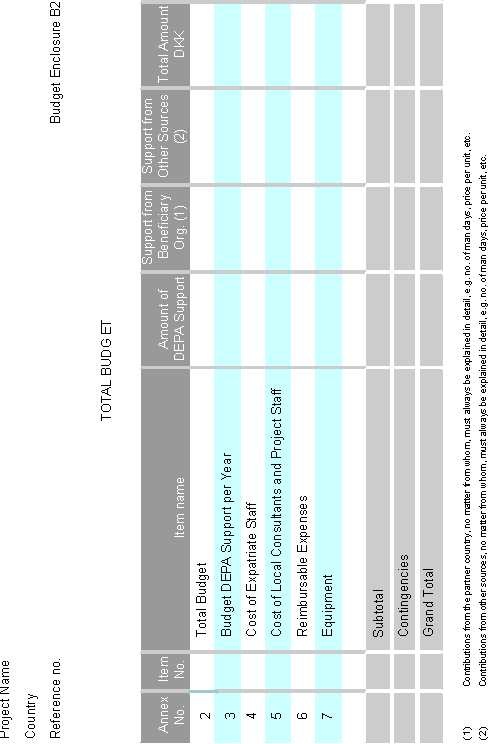
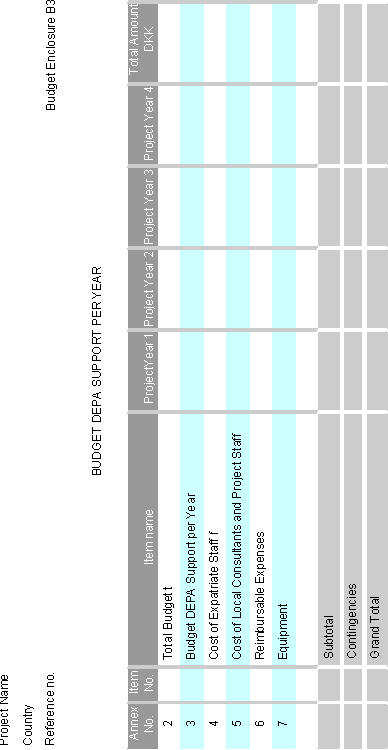
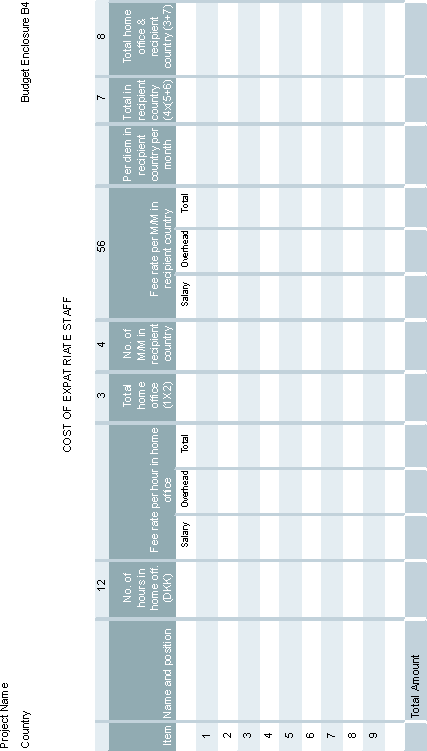
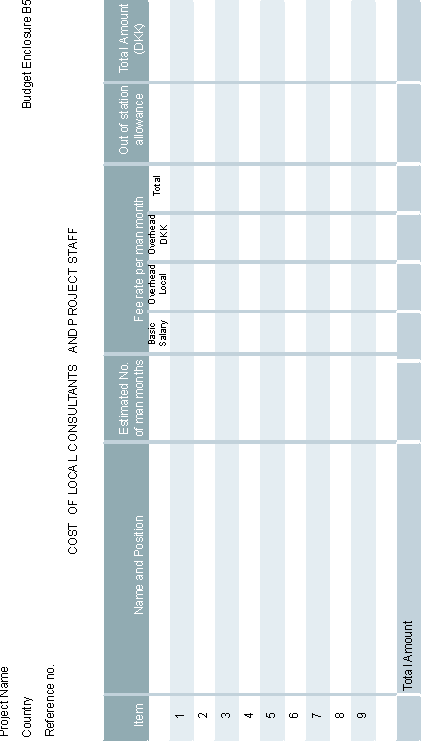
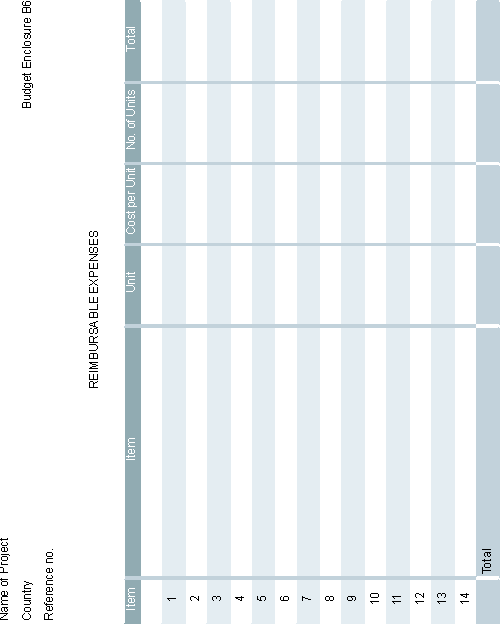
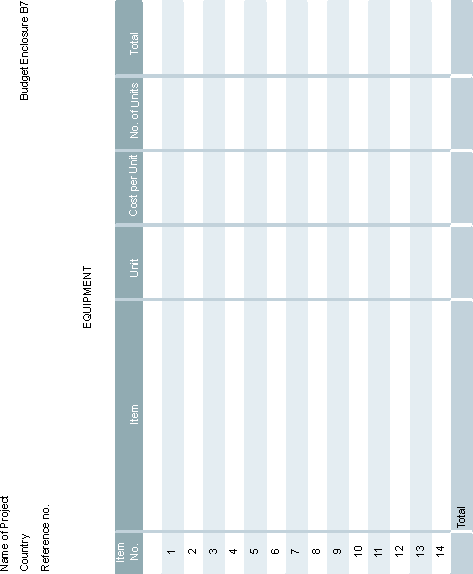
Enclosure b8. Click on thumbnail for full size image (104 kb)
Enclosure C
Terms of Reference Format
Terms of Reference Format
These terms of reference are shown for a mission, but may also be used for other purposes.
1. Preparing Terms of Reference (ToR)
In any development programme or project the Terms of Reference (ToR) specifies the objectives and final outputs of an assignment, and thereby also the success indicators for the assignment. ToR provides the basis for any contract with a consultant.
Below is an outline of a set of ToR with notes on the various sections, plus examples. Sentences written bold are fixed headings and sentences in italics are comments and explanations.
Terms of Reference
for
STATE TITLE OF MISSION
File no/name
Date
1.1 Background
Describe the project background in as much detail as necessary for the assignment. Bear in mind that mission team members may use the Terms of Reference as an introduction to various local organisations/partners/government officials. The level of background detail should therefore be sufficient for someone not directly involved in the project or programme to obtain an adequate idea of the setting for his/her particular assignment.
1.2 Objectives
The overall objective of the mission is:
Describe in words the overall purpose of the mission (in LFA terms). The objective is equivalent to the "Development Objective", i.e. the situation/condition that the assignment will contribute to bring about. The overall objective of the assignment should be stated in terms of quantity, time and location and should clarify to the consultant the overall justification for the assignment.
The specific objective of the mission is:
Describe in words the "immediate objective" of the mission, i.e. the situation/condition prevailing at the end of the assignment (or immediately thereafter) as a result of successful outputs (products) of the assignment. This could be a reviewed and assessed project, or a project identified.
1.3 Outputs
The outputs of the mission are:
a. State mission outputs ("products") as explicitly as possible. Several outputs are likely to be needed to reach the immediate objective of the mission.
b. An output could, for instance, be an appraisal report, , a project document etc. Each output must be specified in five dimensions: time; location; quality; quantity ; target group (i.e. when ? where ? of what quality ?, how much? and with/for whom ?.
c. An output may also be a set of Terms of Reference for a following assignment (mission, study) and/or recommendations as to the organisation and content of a particular project.
d. An output may be a report describing the process which has lead to other outputs.
1.4 Scope of Work (activities)
Scope of work is called "activities" in the LFA. Therefore, this section should in detail list the activities necessary to produce the outputs specified above. For each output there must be at least one activity.
The scope of work for the consultancy will include, but not necessarily be limited to the following tasks:
Re: Output a:
| a.1 | In order to reach each of the above outputs, several activities may be
expected to take place. Such activities typically (as in LFA) start with a verb,
e.g. assess, identify, review, prepare etc. |
| a.2 | Activities described under the scope of work may also provide an opportunity to structure a mission in terms of timing. For instance, it may guide a team about when a workshop (brainstorming session, stakeholder workshop) should be held, and which preparations ( meetings, identification and calling of participants etc.) will be needed beforehand. In this way, the scope of work becomes a powerful tool for the person responsible for guiding the team, and making sure that critical activities are implemented during the assignment, while providing a guideline for consultants and government staff during the work. |
Re Output b:
| Include the activities appropriate to achieve output b etc. |
1.5 Method of Work
In this section, overall guidance to the team on the working methodology is provided. For instance whether the mission is expected to take an expert role, a consultative role, a process-oriented role or a participatory role. This section is important as it may define the mission's boundaries of authority. Tthis section may also describe any reparatory work or local consultations needed.
1.6 Staffing
Include names and positions of all identified staff on the mission, both international and local. If the ToR forms part of a proposal, you should indicate the number of team members and the qualifications that you recommend.
1.7 Timing and Duration of the Assignment
Start with the total duration and timing (when and for how long should the assignment run ?). Then specify for the individual(s) assigned/proposed exactly how much time you foresee for the different phases of work (e.g. preparatory, field visit, report writing etc.).
1.8 Reporting
Include all reporting procedures here. This should include:
- Briefing at head office and country office.
- Debriefing note or summary of findings to be presented prior to departure from the country of assignment. Specify who is responsible for arranging the debriefing meeting and who should attend.
- Report(s) in specific formats (reference can be made to the Manual formats). Any special format requirements (e.g. special summary, special information required or specific wordprocessing programmes to be used) should be mentioned if they differ from the Manual formats.
- Exact timing of report(s) i.e. deadlines for various drafts (including deadlines for DANCEE comments on draft) and final report.
1.9 Inputs
This is the raw material necessary for the contracted party to deliver the activities and outputs. When stating input, monetary inputs are NOT included - they are regulated in the contract. But it includes all resources and support that DANCEE, local authorities/agencies/establishments or other simultaneous missions will be able to provide to the consultant.
Examples could be:
- DANCEE CC (name of person responsible) will arrange for xxx
- Local project coordinator (name of person responsible) will provide yyyy reports,
Stating and specifying the inputs lets the assigned consultant know exactly what support can be expected from DANCEE (and what not) and identifies the responsible contact person is.
1.10 Attachments
Include a list of attachments (e.g. LFA guide, policy guide, DANCEE Project Cycle Management Manual, project papers and reports for preparation etc).
Enclosure D
Appraisal Report Format
Appraisal Report Format
Appraisal reports will be submitted in English and should include the parts highlighted below. Sentences written in bold are fixed headings and sentences in italics are comments and explanations.
Cover Page
Map of Location
List of Abbriviations
List of Contents
1. Introduction
A brief presentation of the project including project name, country, objectives, timing and size of budget.
Brief presentation of the appraisal team.
The events preceding the assignment of the appraisal team and the timing of the appraisal.
In connection with field appraisals only, the following two clauses should always be inserted in the introduction:
"The team would like to express its thanks to all officials and individuals met for their kind support and for the valuable information which the team received during its stay in (country), which facilitated the work of the team."
"This report contains the views of the team which do not necessarily correspond to the views of DANCEE or the government of (country). All proposals are subject to approval by the two governments."
2. External Relevance
Is the project in line with DANCEE priority areas?
Is the project in line with DANCEE priority criteria?
Is the project in line with the country programme?
Does the project conform with the institutional set-up and organisation in the partner country?
3. Internal Quality
Does the project document fulfil the formal requirements?
Is the problem analysis satisfactory?
Is the project strategy realistic, i.e. will the proposed inputs and activities lead to the expected outputs, and are the outputs of the project sufficient and relevant to the achievement of the projects objectives?
Are the assumptions realistic?
Have key potential risks been identified and assessed?
Is the budget realistic?
Is the time frame realistic?
Has an adequate monitoring system been proposed
Is it realistic that the proposed beneficiary and involvement of stakeholders will secure effective implementation of the project?
4. Presentation
Is the language correct, straightforward and easy to understand?
Is the information presented sufficient for a person without previous involvement in the pro-ject to understand and begin implementation it?
5. Decisions and Recommendations
Is the project suitable for DANCEE support?
Are any changes to the project document proposed?
Do any preconditions have to be fulfilled before DANCEE support can be granted?
6. Annexes to the Appraisal Report
ToR for the Appraisal Team
Enclosure E
Guidelines for Steering Committee Meetings
Guidelines for Steering Committee Meetings
1. Procedure
Meetings are held according to the regulations provided in the project document, usually quarterly.
The team leader is responsible for identifying candidates for the steering committee. This will be done in close co-operation with the local project director nominated by the MoE. It is likewise the responsibility of the team leader to secure DANCEE’s approval of the steering committee members no later than six weeks after the start of the project.
The team leader shall act as secretary to the steering committee.
2. Order of Business
DANCEE recommends that the following order of business be used at all steering committee meetings.
- Introduction to the meeting and presentation of the participants.
- Approval of the proposed order of agenda.
- Approval of the minutes from the last meeting.
- Verbal report from the team leader of project progress since the last meeting.
as a minimum this will always include:
| is the project implemented according to the project document and the PIP | |
| report on completion of training activities | |
| report on completion of tests and measurements | |
| introduction of new experts arrived at the project | |
| information about major deliveries of goods | |
| completion of major works | |
| major contracts for services and goods to be implemented before the next meeting. |
- Presentation of reports for approval by the steering committee.
- Next meeting.
- Any other business.
Enclosure F
Covering Letter to Progress Report
Covering Letter to Progress Report
Project Ref. No.
Project Name:
Reporting Period:
| Activities have been conducted according to plan | Yes | No |
| Equipment has been delivered according to plan | Yes | No |
| Project staff has been fielded according to plan | Yes | No |
| Funding has been spent according to plan | Yes | No |
| Beneficiary has participated in project implementations according to plans | Yes |
No |
| Project management has been performed according to plans | Yes |
No |
|
Date |
Project Holder Signature |
|
Date |
MoEE Representative Signature |
Enclosure G
Letter of Confirmation
Letter of Confirmation
This Letter of Confirmation is issued by ___________ (Beneficiary) to the Danish Co-operation for Environment in Eastern Europe (DANCEE) for purposes of DANCEE’s considerations of making available a grant for a project with the title ___________(title) as described in the Project Document (Project) dated ____________ (date).
By this Letter of Confirmation, the Beneficiary confirms
that the Beneficiary wishes that the Project is implemented,
that the Beneficiary accepts the content of the Project Document,
that the Beneficiary appreciates the nature and scope of the inputs to the Project from the Beneficiary as specified in the Project Document (the "Input"),
that the Beneficiary will endeavour to (a) make the Input available to the Project, and (b) facilitate the implementation of the Project in ways as may be reasonably expected by DANCEE, and
that the Beneficiary will timely report to the Steering Committee or the Project Holder (if no Steering Committe is established) any foreseeable failure in terms of these endeavours along with proposals for the remedy of the failure.
By this Letter of Confirmation, the Beneficiary acknowledges
that the above confirmation will be part of the basis for DANCEE’s decision to make a grant available to the Project, and
that any failure by the Beneficiary to make the Input available timely and without hesitation may cause DANCEE to reduce or discontinue the Project.
This Letter of Confirmation shall be annexed to the Project Document.
Date
Signature of Beneficiary
Enclosure H
List of DANCEE Indicators
The following indicators are used in the DANCEE statistical summary
| Sector | Indicator | Unit |
| A.1. Energy production | Other | t/year |
| Carbon dioxide CO2 | t/year | |
| Nitrogenoxide NOX | t/year | |
| Sulphurdioxide SO2 | t/year | |
| Particles (flying dust) | t/year | |
| Equipment | ||
| A.2. Environmentally friendly energy | Other | t/year |
| Carbon dioxide CO2 | t/year | |
| Nitrogenoxide NOX | t/year | |
| Sulphurdioxide SO2 | t/year | |
| Particles (flying dust) | t/year | |
| Equipment | ||
| A.3. Industry etc. | Other | t/year |
| Carbon dioxide CO2 | t/year | |
| Nitrogenoxide NOX | t/year | |
| Solvents | t/year | |
| Sulphurdioxide SO2 | t/year | |
| Particles (flying dust) | t/year | |
| Equipment | ||
| A.4. Recipient | Equipment | |
| A.5. Ozone depleting substances (ODS) | Reduction of ODS | t/year |
| B.1. Drinking/ groundwater | Pipeline established | km |
| Amount of water produced | m3/year | |
| Water savings | m3/year | |
| Equipment | ||
| B.2. Wastewater | Pipeline established | km |
| Phosphorus reduction (P) | t/year | |
| Oxygen demand reduction (COD) | t/year | |
| Nitrogen reduction (N) | t/year | |
| Oxygen demand (BOD) | t/year | |
| Sludge treatment capacity, dry | t/year | |
| Wastewater | m3/year | |
| Equipment | ||
| B.3. Industry wastewater | Savings/ reduction | m3/year |
| Hazardous waste reduction | t/year | |
| Phosphorus reduction (P) | t/year | |
| Oxygen demand reduction (COD) | t/year | |
| Nitrogen reduction (N) | t/year | |
| Oxygen demand (BOD) | t/year | |
| Heavy metal reduction | t/year | |
| Equipment | ||
| B.4. Recipient | Equipment | |
| B.5. Oil pollution prevention | Oil pollution reduction | t/year |
| Equipment | ||
| C.2. Solid waste | Landfill capacity established | t/year |
| Incineration capacity | t/year | |
| Waste volume reduction | t/year | |
| Equipment | ||
| C.3. Hazardous waste | Landfill capacity established | t/year |
| Incineration capacity | t/year | |
| Recycling, reduction | t/year | |
| Equipment | ||
| D. Institutional strengthening | Consultancy services | Man months |
| Equipment | ||
| E. Nature protection | Nature protection | hectare |
| G. Nuclear matters | Radiation sources | no. removed |
| Equipment | ||
| I. Other | Equipment |
Enclosure I
References
References
- Danish Environmental Support Fund for Eastern Europe, 1998; Co-operation Development 1991 -1996 and Programme Priority Areas. DEPA.
- Strategy for Danish Co-operation for Environment in Eastern Europe, 1999. DEPA.
- Retningslinier for Revision. Finansministeriet 1999
- Logical Framework Approach - A flexible Tool for Participatory Development, Danida 1995.
- The Logical Framework Approach, Handbook for objectives-oriented planning. Norad 1996.
[Front page] [Contents] [Previous] [Top] |
